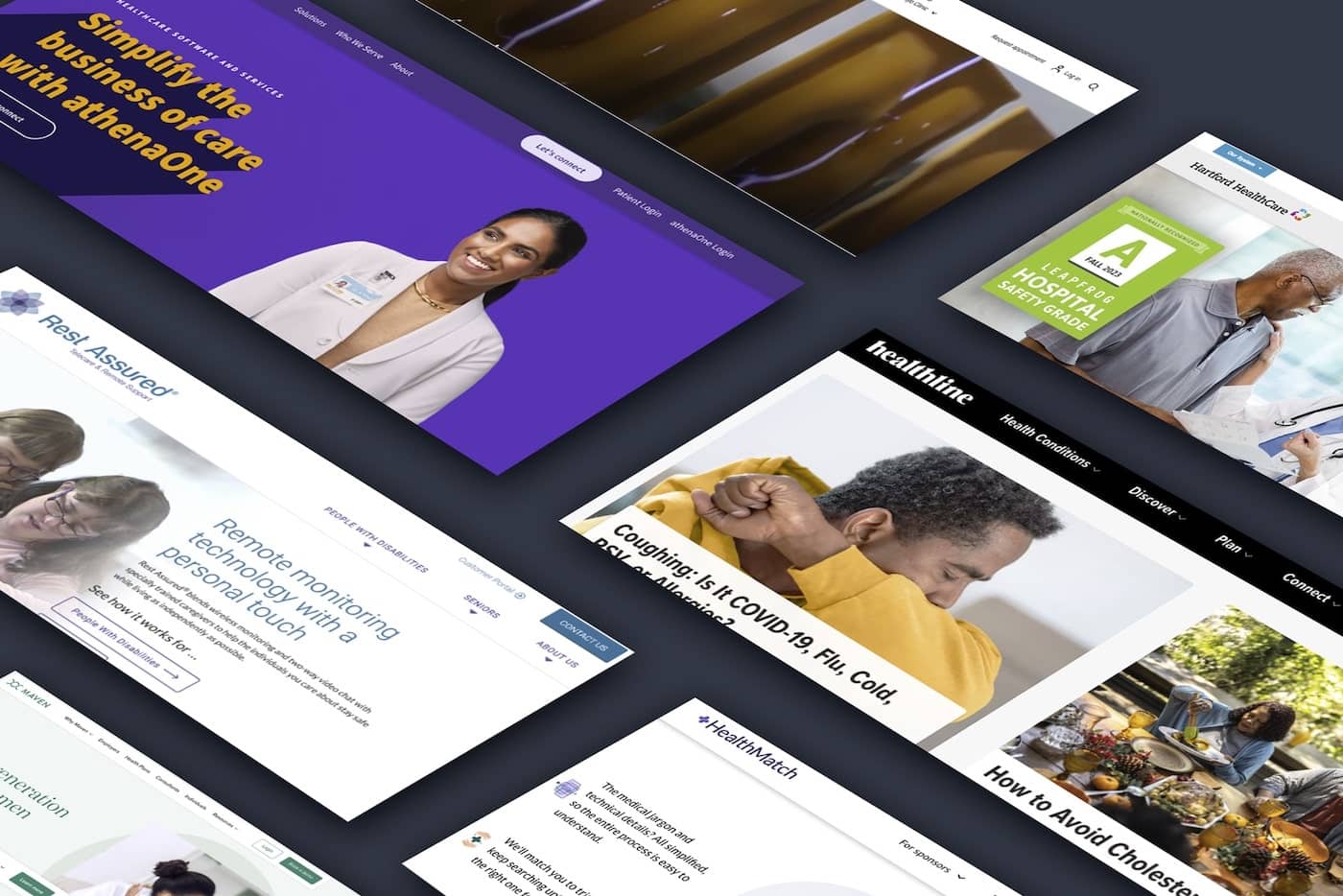

Is Your Website ADA Compliant?
Your website is your digital front door – an extension of your business. For many organizations, it’s where all business takes place. That's why web accessibility has become a priority for organizations worried about the liability risk of websites that are not ADA compliant.
Does Your Website Have to be ADA Compliant?
Bottom line: If your website or app is not ADA compliant, you’re tempting fate and ultimately delaying the inevitable. The risk of being sued is real, as the number of lawsuits filed for inaccessible websites keeps growing.

In 2018, there were over 2,200 federal lawsuits alleging company websites were not compliant with the Americans with Disabilities Act (ADA) of 1990. That’s a massive 177% increase over 2017.
Already in Q1 of 2019, the filings are up 30% over Q1 of last year.
In January, a federal appeals court upheld that Domino’s Pizza must make its website and mobile app accessible after a customer, who happened to be blind, sued Domino's for being unable to order a pizza on the site.
While the list of sued organizations keeps growing, the primary targets of accessibility lawsuits have been food service companies, restaurants, retailers, grocers, universities, and financial service providers.
Read more: Why Today’s Accessibility Standards Prepare You For Tomorrow’s Tech
Beyond consumer-facing websites, corporations must also address their internal-facing employee websites or intranets. As companies build more diverse workforces that increasingly work remotely and access work resources through digital channels, these digital tools and platforms must also become ADA-compliant. It's not just desktop and mobile––other overlooked liability risks include kiosks offering company information or customer service, as these are digital platforms that fall under the ADA mandate.
Why ADA Compliant Websites are Good for Business
Avoiding lawsuits should be reason enough for organizations to remediate their websites quickly, but if they need more convincing, there is also a strong business case for accessible websites improving their bottom line. Here are a few reasons:
- Accessible websites are easier for any person to use – This makes purchasing easier for a wider swath of digital customers. As an example, British supermarket giant Tesco saw a 30x increase in profits after just one year since launching their accessible website! Virgin.com also saw a 60% increase in online sales when it added accessibility features.
- Web accessibility boost a website's SEO – Major search engines like Google give preference to accessible websites because of their clean user experience, improving their rank and position on search engine results pages (SERPS) and making it easier for customers to find them online.
- Accessibility features give search engines more ways to identify relevant content for targeted keywords – Best practices like well-written alt tags and transcripts of video and audio content help search engine crawlers apply context to your website content hierarchy.
- As sites with digital accessibility earned increased traffic that converts, that also signals to search engines that the site has more credibility, further boosting its SEO.

Website Compliance Laws
What is Title III?
Most businesses fall under Title III of the ADA, unless they do significant business with the federal government, which is covered by Section 508 of the Rehabilitation Act. State and local governments fall under Title II.
Here’s what the law says regarding Title III:
“No individual shall be discriminated against on the basis of disability in the full and equal enjoyment of the goods, services, facilities, privileges, advantages, or accommodations of any place of public accommodation by any person who owns, leases (or leases to) or operates a place of public accommodation.”
The majority of lawsuits filed thus far have centered on a lack of digital accessibility for blind or visually impaired individuals.
However, to comply with the ADA, websites will also need to be accessible to individuals with physical, mental and neurological impairments.
Disabilities covered under the ADA
- Blindness
- Hearing impairments
- Mobility/Musculoskeletal
- Epilepsy
- Neurological/Cognitive
- Cerebral Palsy
What is Section 508?
Section 508 of the Rehabilitation Act of 1973 requires that electronic and information technology (ICT) developed, procured, maintained, or used by the Federal government be accessible to people with disabilities. It applies to more than digital services, including phones, computers, peripherals, and office machines as examples.
Web services offered on federal government and agency websites must also be accessible. In addition, private contractors and the financial, healthcare, and legal organizations with peripheral connection to these federal organizations may also be required to comply with Section 508.
Even beyond their websites, any digital documents, such as PDFs, must also be digitally accessible.
How do ADA Compliant Websites Work?

Users with visual impairments can struggle with websites that are not ADA compliant
ADA compliant websites can be used by web visitors with visual impairments if they are designed and coded to offer keyboard navigation as well as compatibility with screen reader tools, among other features.
For individuals with hearing impairments who couldn’t otherwise take full advantage of media-rich websites, text transcripts offer an alternative for consuming audio and video content.
Read more: ADA Compliance Starts with Accessible Design
While many of us take for granted the ease of navigating websites with a mouse, many people with mobility challenges need a more reliable method of clicking links and buttons.
The issues facing individuals with cognitive or neurological impairments are often less obvious. Flashing images, moving text, or image carousels may accidentally cause seizures, or otherwise be too challenging for people with cognitive disabilities to comprehend.
How Website ADA Compliance Affects You
Reebok, Harvard, Williams-Sonoma, Winn-Dixie, Marriott, Domino’s Pizza, Beyoncé, and Playboy are just a handful of companies that have been hit with web accessibility lawsuits.

For ADA compliance, there's no time like the present
You might be tempted to say, “I’m not big like them. I don’t have to worry.” Resist that temptation. Complacency is not your friend. Remember, new ADA compliance lawsuits are filed every day.
3 Reasons to be Proactive about Web Accessibility
- Lawsuits are costly – Not only do you have to shoulder the cost of counsel to defend yourself, but you will also be on the hook for the legal expenses for the opposing counsel if you lose. The odds are not in your favor.
- Damage to your reputation – The court of public opinion is not kind. Now in a time of social media, a reputation can be harmed irreparably all too quickly.
- The opportunity cost – Spending time dealing with a lawsuit takes attention away from other core responsibilities within your organization.
ADA Compliance is the Law – What Courts Say You Should Do
When the Americans with Disabilities Act passed in 1990, the Internet, let alone apps for smartphones, was not a consideration. Regulations for physical spaces have been hammered out over the years, so businesses can rely on them to achieve and maintain ADA compliance.
That’s not the case with accessibility in the digital space. While the United States Department of Justice is responsible for regulations, the current administration pushed the development of regulations to the back burner. In other words: Don’t count on the DOJ to provide clarity here, at least not in the near future.
However, an important note: This lack of regulatory guidance does not - we repeat, does not - eliminate the need for complying with the ADA.
To be clear, the DOJ told members of Congress in a letter that “the Department has consistently taken the position that the absence of a specific regulation does not serve as a basis for noncompliance with a statute’s requirements.”
Moreover, the ADA is what's known as a "no-fault" statute–meaning ignorance of ADA requirements is not an acceptable excuse in the eyes of the law. You can't be sued for a noncompliant website, then claim you were unaware of your obligation to provide digital accessibility. Whether you knew it or not, your website broke the law, and your organization will suffer whatever consequences are handed down by the courts.
Frustration is Understandable
Understandably, the “Just do it, you figure it out” mandate is leaving businesses frustrated.
While Section 508 of the Rehabilitation Act applies to federal agencies and contractors, as discussed earlier, with a body of clear documentation for accessibility compliance, similar Title III documentation doesn’t exist for non-government entities and businesses.
But there is still guidance that can help. In fact, Section 508 compliance relies primarily on the World Wide Web Consortium’s (WC3) WCAG 2.0/2.1 Web Content Accessibility Guidelines. W3C is an international organization developing clear criteria for web best practices, and has been considered the guiding force for accessibility in the digital space.
While we can’t and don't offer legal advice here, we believe websites and apps built according to the latest WCAG guidelines offer your organization the best path to digital accessibility compliance.
How Do I Make My Website ADA Compliant?
DBS Interactive has been building accessible websites and applications for over 20 years. Everything we design and develop is WCAG 2.0/2.1 Level AA compliant. Accessibility is at the core of everything we do.
Here are some ways to get on the road towards ADA compliance
- Be fluent in the language of accessibility. A good first step begins with having a basic understanding of ADA compliance. Review our glossary of key terms used to discuss ADA compliance. There are many acronyms and concepts. It can be dizzying at first, but you'll eventually get comfortable.
- Order an assessment of your digital properties, like your website, to determine their level of compliance - or noncompliance. Quantitative and qualitative digital accessibility audits give you a good understanding of vulnerabilities within your website(s) or app(s). DBS Interactive offers website audits.
- Create and maintain an internal web accessibility policy to ensure the website remains compliant.
- Show initiative: Publish an accessibility statement on your app or website that outlines your efforts for producing and maintaining an accessible website. Say what you’re doing and then do what you say. It may help hold off a lawsuit if you have demonstrated a clear plan for an ADA compliant website. Follow through on that plan. Here's our Accessibility Statement.
- Provide ongoing accessibility training for web developers and managers, to hedge against future digital accessibility issues and gaps in compliance.
The long-term benefits of an ADA compliant website far exceed the risk of waiting and hoping a lawsuit doesn’t arrive. It’s not a matter of if, but when.
Read more: An Accessible Website Shouldn’t Be Cost Prohibitive
DBS Interactive has extensive expertise in building ADA compliant websites, apps and other digital experiences, as wells as digital accessibility audits and remediation of existing sites. Contact us if you need help becoming ADA compliant.



